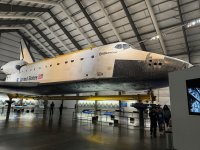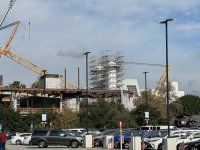This is the distinction between contra-grav (which makes the item "have no weight", but it does have mass), and "gravitic thrust", manipulating gravity in order to provide thrust.
With contra-grav, you can just lift the bridge up "from the proper points" as high as you want. Specifically, you do not need escape velocity because, by definition, with contra-grav, you are already, essentially, at escape velocity. So, even streamlining isn't an issue, as you can travel slow enough for it to not be an issue. (Modulo however fast winds travel in the upper atmosphere, honestly I have no idea.)
Gravtic thrust is no different than rockets or anything else. Here you DO need escape velocity, you DO need to be going "very fast", and this the "streamlining" of the bridge will impact the success or not of trying to get to orbit.
The happy path is a combination of contra-grav and gravitic thust so that you can move and accelerate within the gravity well of the planet, but with a body that is weight neutral. The gravtic thrust is nice because, unlike rockets, it's doesn't incinerate, well, everything.
And it's much easier to brake.
With contra-grav, you can just lift the bridge up "from the proper points" as high as you want. Specifically, you do not need escape velocity because, by definition, with contra-grav, you are already, essentially, at escape velocity. So, even streamlining isn't an issue, as you can travel slow enough for it to not be an issue. (Modulo however fast winds travel in the upper atmosphere, honestly I have no idea.)
Gravtic thrust is no different than rockets or anything else. Here you DO need escape velocity, you DO need to be going "very fast", and this the "streamlining" of the bridge will impact the success or not of trying to get to orbit.
The happy path is a combination of contra-grav and gravitic thust so that you can move and accelerate within the gravity well of the planet, but with a body that is weight neutral. The gravtic thrust is nice because, unlike rockets, it's doesn't incinerate, well, everything.
And it's much easier to brake.



